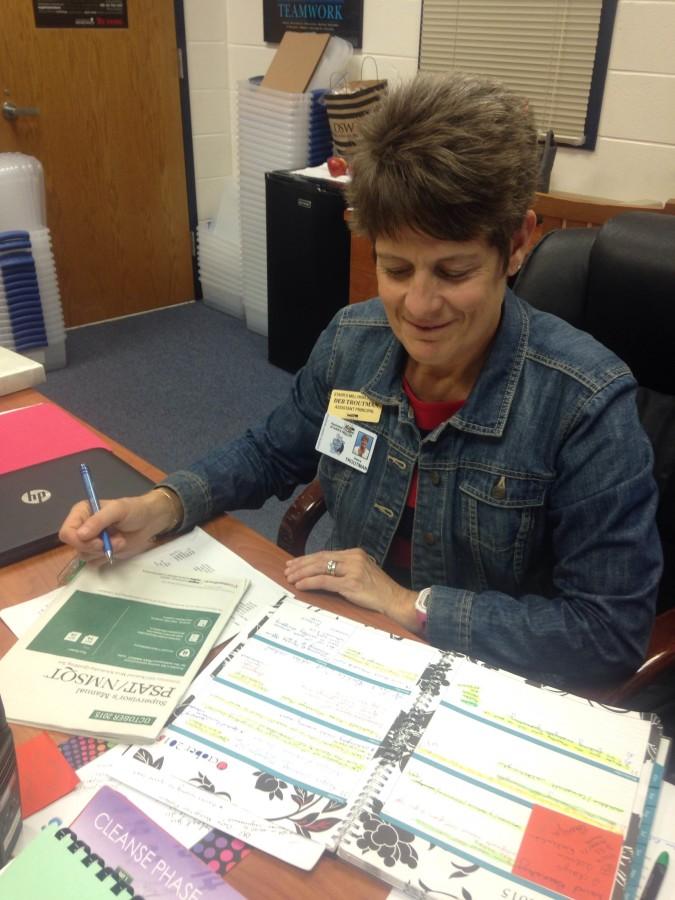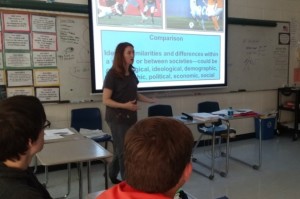Reformed SAT reforms student attitudes
Assistant principal Deb Troutman works on scheduling the PSAT proctors so all teachers still have one planning period during the Oct. 14 testing.
October 30, 2015
For the first time since 2005, College Board’s SAT is undergoing a major formatting and context face lift.
Reverting back to a 1600 score scale versus the current 2400 scale, the newly reformed SAT makes its debut March 2016. According to College Board, “One of our biggest goals in changing the SAT is to make sure it’s highly relevant to your future success. The new test will be more focused on the skills and knowledge at the heart of education.”
According to the board’s website, the new test will include a no-calculator section, an optional writing section and “no vocab that you’ll never use again.” In addition, the “guessing penalty,” a reduction of a quarter point for each incorrect multiple choice answer, no longer exists. These changes went into effect for the 2015 PSAT, open to freshmen, sophomores and juniors at the Mill on Sept. 14. The Mill requires all sophomores to take the PSAT, but freshmen and juniors may register as well for a fee of $20. Additionally, juniors are eligible for the National Merit Scholarship.
This year, administrators allotted an additional hour for the PSAT, which spanned from first period until the beginning of C lunch. The test’s information section also doubled in length, taking over an hour to complete prior to the actual test itself. “The test itself was a little longer, but the bubbling section went from four pages to eight pages,” assistant principal and testing coordinator Deb Troutman said. “To think that a student had to sit there over an hour before they began the actual test? That’s just too long.”
The length of the test was not only disconcerting for the administrators and proctors but for the test-takers as well. “It felt extremely long and caused more mental fatigue from the length of the test,” said sophomore Colin Kelly, who took the PSAT both his freshman and sophomore year.
Certain changes in the PSAT sections, however, made the minutes seem to tick away quickly. “I didn’t realize how little time we had for the no-calculator section,” junior Katie Lindley said.
Kelly agreed that the time crunch made that portion of the math section more difficult. “The no-calculator section was a negative change since many questions took much longer to complete without a calculator,” he said.
In addition to the test being “excessively long,” Kelly noted other changes in the content of the test. “The removal of unknown vocabulary was a benefit in helping understand the test but should be used on the more challenging questions instead of completely removing them,” Kelly said.
Other students support the somewhat mild change to the English section. “I have a neutral feeling on the vocab, but I’m thankful that I don’t have to study SAT words as much,” junior Sky Dedrick said.
English teacher Lela Crowder teaches the SAT Prep class at the Mill. With the drastic changes to the test’s content, Crowder must redesign her class structure. “This semester I’m covering the old SAT, and next semester I can focus on the new test,” she said. “The new SAT isn’t until March, and kids still want to prepare for the old one.”
The redesigned test received a complete makeover of the course content and material as well. “It’s difficult to plan the class because there isn’t much practice or released material yet,” Crowder said.
As the only teacher with such a class in the county, Crowder assembles and selects coursework on her own, which spans from standardized tests to college applications to brag sheets. “I have to scrap years worth of work, and I’ve been teaching this class for seven or eight years.”
In spite of all the reforms and scheduling changes that came with the new PSAT, the students and administrators remained positive during testing. “At most schools you’d still be trying to quiet down the kids, and just being able to get the kids to settle down and pay attention was great,” Troutman said in response to supervising hundreds of students at once. “We just have a really really good population of kids here at the school.”







